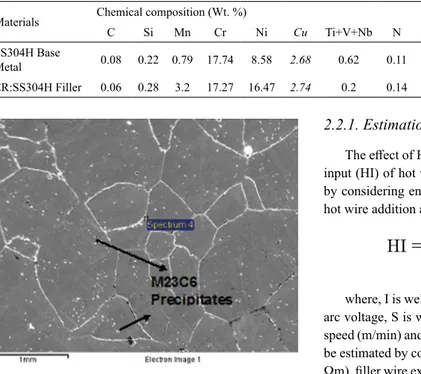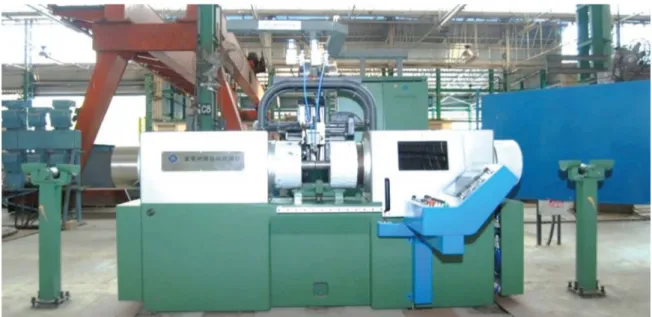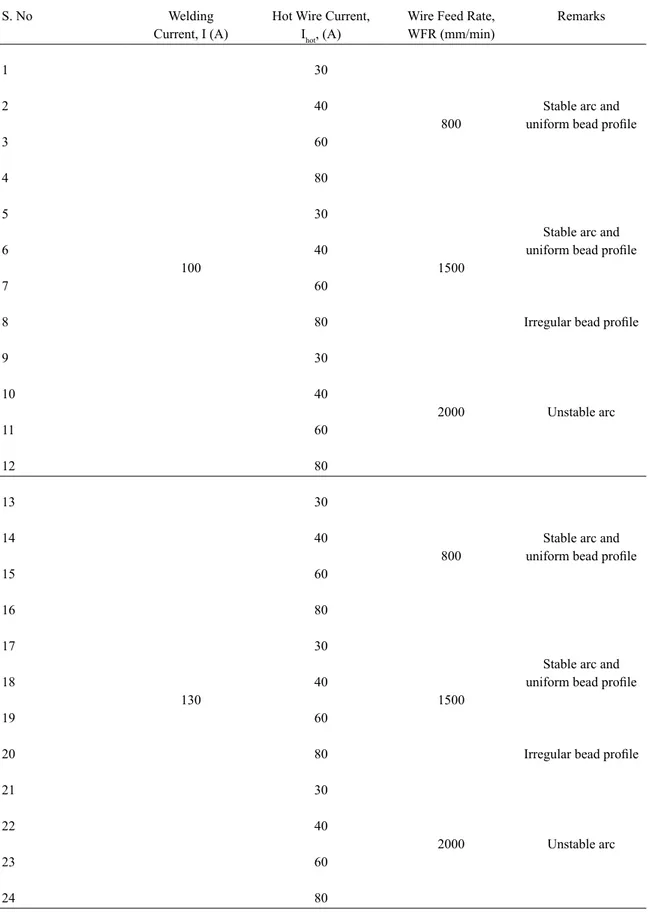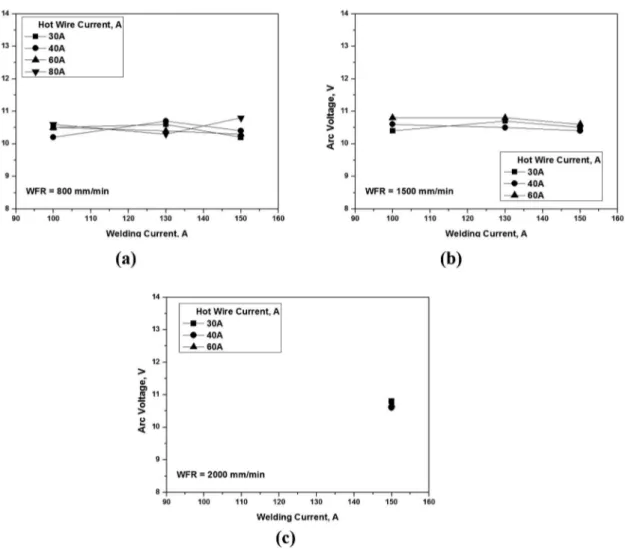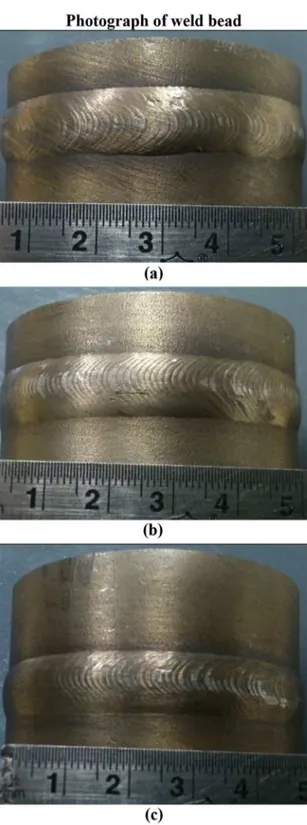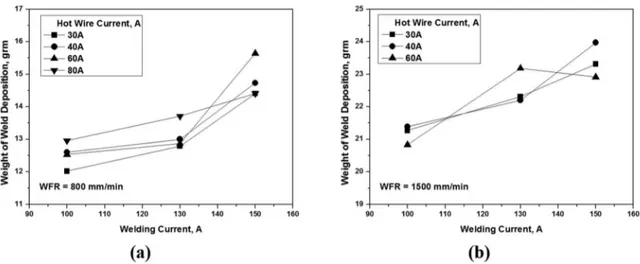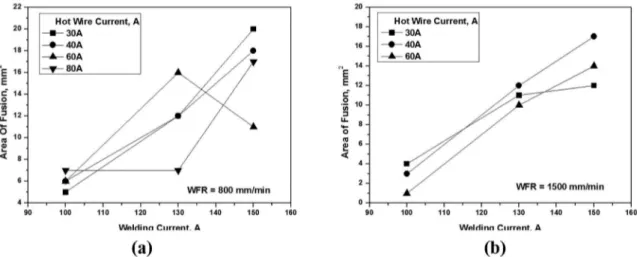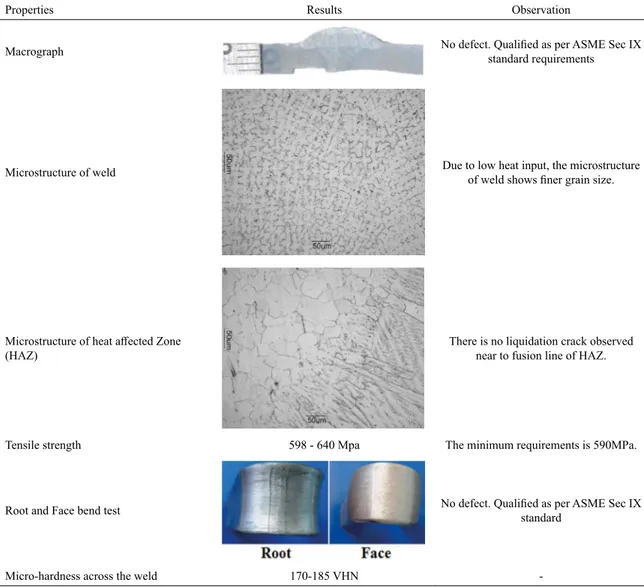A Study on Process Characteristics and Performance of Hot Wire Gas Tungsten Arc
Welding Process for High Temperature Materials
Anantha Padmanaban MRa*, Baskar Neelakandana, Devakumaran Kandasamyb
Received: April 23, 2016; Revised: August 11, 2016; Accepted: September 7, 2016
Hot wire gas tungsten arc welding (HW-GTAW) process is the one where the iller wire is pre-heated close to its melting point before it is fed in to the arc. The efect of HW-GTAW parameters such as welding current, hot wire current and the wire feed rate during welding of super ASS 304H stainless steel tubes were evaluated in terms of heat input, voltage-current (V-I) characteristics and weld bead characteristics such as bead weight and geometry. The results obtained indicate that for a constant welding current, increasing the hot wire current and wire feed rate provides a stable V-I characteristics and higher bead weight. Further, increasing the hot wire current and wire feed rate also provides better or desired weld pool and hence the bead geometry was described in terms of width, penetration depth, area of fusion and toe angle. By utilising the above knowledge, the tube to tube butt welding of SS 304H material was carried out. It was observed that, the weld joint is qualiied as per the quality requirement of ASME: Sec IX standard.
Keywords: Super 304H, Hot wire, Bead geometry, Heat input
* e-mail: mrpadmanaban-mech@saranathan.ac.in
1. Introduction
Hot wire gas tungsten arc welding (HW-GTAW) process is a modiied gas tungsten arc welding (GTAW) process in which the iller wire is pre-heated before entering the weld pool1. As the iller wire is pre-heated, the weld deposition
eiciency of HW-GTAW process is higher when compared to the conventional GTAW process. HW-GTAW process is speciically used to weld many high temperature materials that are used by the power industry2,3. It is a known fact that the
quality of a weld joint is inluenced by the welding parameters. In conventional GTAW there are three primary variables viz., arc voltage (V), welding current (I) and travel speed which determine the heat input of the process4. In case of HW-GTAW
process, as the iller wire is resistance heated before entering the weld pool, the current used to heat the iller wire, referred as hot wire current also inluences the quality of welding. The voltage (V) - current (I) characteristics of the power source may also change and accordingly inluence the performance of the HW-GTAW process. Though many research work has been carried out on evaluating the V-I characteristics and its inluence on weld quality in conventional GTAW5,6, studies
on HW-GTAW process are rather sparse7. The reason being,
HW-GTAW can be carried out only in automated or mechanised conditions which can exercise control over welding parameters like arc voltage (V), wire feed rate (WFR), hot wire current (Ihot) and welding current (I) to provide a desired stable arc under dynamic operating conditions of welding. In addition, adequate V-I characteristics also required for the iller metal
melting requirements. As the existing information on this process is limited, it is imperative to study the individual and synergistic efect of HW-GTAW process variables such as welding current, hot wire current and wire feed rate on the weld quality.
In the current work, the efect of the aforementioned process variables of HW-GTAW of super 304H stainless steel tube used for boiler manufacturing has been evaluated by characterising the welding process and joint for (a) heat input (b) V-I characteristics (c) weight of the metal deposited and (5) bead geometry described in terms of bead width, depth of penetration, area of fusion and deposit, toe angle. By utilising the above knowledge, optimised HW-GTA welding parameters were derived for production of tube to tube butt weld joint of super 304H material. Further, the mechanical and metallurgical properties of the weld joint studied as per the quality requirements of ASME: Sec IX standard. The results obtained are presented and discussed here.
2. Experimental
2.1. Material
The material used for the study is super 304H austenitic stainless steel tube with a thickness of 4.5 mm and 63.4 mm outer diameter. The nominal composition of the material is shown in Table 1. This material is widely used in high temperature regions of boiler that are exposed to a temperature of 550- 650oC. The
microstructure of as-received tube shown in Figure 1 exhibits austenitic grains with MC precipitate (Mainly M23C6). aDepartment of Mechanical Engineering, Saranathan College of Engineering, Trichy, Tamil Nadu, India
Table 1: Chemical composition of base metal and iller wire.
Materials Chemical composition (Wt. %)
C Si Mn Cr Ni Cu Ti+V+Nb N P S Mo B Others
SS304H Base
Metal 0.08 0.22 0.79 17.74 8.58 2.68 0.62 0.11 0.015 < 0.01 0.35 < 0.001 Fe, Bal. ER:SS304H Filler 0.06 0.28 3.2 17.27 16.47 2.74 0.2 0.14 <0.01 < 0.01 0.94 < 0.001 Fe, Bal.
Figure 1: Typical microstructure of base metal.
2.2. HW-GTA welding
Hot Wire Gas Tungsten Arc (HW-GTA) welding on 304H austenitic stainless steel (ASS) was carried out using 1.0 mm diameter austenitic stainless steel wire of grade ER: 304H (Table 1) with Panasonic-YC400 direct current (DC) welding power source. During the welding process, the tube was rigidly ixed in a fully automated welding lathe that has synchronised rotation of head and tail stock. The welding power source, welding torch, mechanised hot wire feeder and automatic torch positioning system were itted on welding lathe as shown in Figure 2. The welding parameters such as welding current (I), wire feed rate (WFR), hot wire current (Ihot), welding speed, iller wire extension and arc gap were programmed and controlled using the control panel attached with the welding lathe. Entire operation of HW-GTAW was monitored and controlled using a M/s. W.Tech make PLC programmer. Commercial pure argon (99.98%) shielding gas was passed at 15 lpm during the welding operation. Prior to welding, the base metal was cleaned with acetone. The welding parameters used for the current are listed in Table 2. Weld bead deposition or welding was carried out over the entire (360°) diameter of tube. welding process and joint for heat input, V-I characteristics, weight of the metal deposited and bead geometry described in terms of bead width, depth of penetration, area of fusion and deposit, toe angle.
Based on the bead on tube studies, the optimised HW-GTA welding parameters were derived is given in Table 3. By using Table 3 welding parameters, tube to tube butt welding of super 304H has been carried out using same grade of iller wire (Table 1) under commercial pure argon gas shielding environment.
2.2.1. Estimation of Heat Input
The efect of HW-GTAW process variables on the heat input (HI) of hot wire GTAW process has been estimated by considering energy produced through welding arc and hot wire addition as follows9.
( )
HI
I R
V
VI
S
1
w
hot h
2
=
+
where, I is welding current, Ihot is hot wire current, V is arc voltage, S is welding speed (cm/min), Vw is wire feed speed (m/min) and Rh is resistance of iller wire (Ω). Rh can be estimated by considering resistivity of iller material (ρ, Ωm), iller wire extension (L, mm) and cross sectional area of iller wire (Aw, mm
2) as shown below9.
( )
R
hA
L
2
w
t
=
For AWS: ER 304H grade iller metal, the resistivity ρ is considered as 6.47×10-7 Ωm9.
2.2.2. Studies on V-I Characteristics
The efect of hot wire welding parameters on change in arc voltage (V) and welding current (I) during welding was measured with the help of weld data acquisition software connected to HW-GTAW system.
2.2.3. Studies on Performance of HW-GTAW
Process
The performance of HW-GTAW process under diferent welding current, hot wire current and wire feed rate were studied by measuring the weight of weld metal deposited (WD) and bead geometry. The WD is measured as weight of material before and after welding by using weighing machine having least count of 0.001g. The geometry of weld bead was also evaluated on polished and etched (10% Oxalic Acid) transverse section of weld bead as schematically represented in Figure 3.
2.2.4. Studies on Weld Joint Characteristics
Figure 2: Photograph of HW-GTAW setup.
polished and etched (10% Oxalic Acid) transverse section of weld joint. The mechanical properties such as tensile, bend and hardness across the weld joint have been carried out as per the standard requirement of ASME: Sec IX.
3. Results and Discussion
During HW-GTAW using the process parameters listed in Table 2, it was observed that, for a WFR of 2000 mm/min, the welding arc was stable only at higher welding current of 150 A irrespective of hot wire current. Further, it was also observed that while varying the welding current, the arc length was not uniform throughout the weld length for a given hot wire current of 80A, and WFR of 1500 mm/min. This results in irregular bead proiles as shown in Figure 4a and 4b. Therefore, in the current study, on those conditions of wire feed rate, welding current and hot wire current that produces a stable arc and visibly acceptable weld bead proile were considered for further investigation.
3.1. Heat Input
During hot wire GTAW process, two heat sources of diferent nature act concurrently on weld pool. One is a continuous heat source (arc heat source) of double ellipsoidal nature acting at the surface of base plate, which melts and produces an initial weld pool in the base metal. The other is a resistance heating of iller metal (Q) and it is considered as a point heat source dictating the weld size and deposit over the initially developed by the arc heating. It is well known that, the resistance heating of iller wire can be varied by varying hot wire current (Ihot) and iller wire extension (L). Under these circumstances, the efect of ‘L’ on resistance
heating produced under diferent hot wire current has been studied and it is shown in Figure 5. It is observed that, at a given hot wire current, increase of ‘L’ enhances Q. Further, it is noticed that, at a given ‘L’, increase of Ihot also enhances
the Q. The correlation of Q as a function of ‘L’ and Ihot is
given by equation (3) and it is maintaining the coeicient of 0.99. The correlation can be used to estimate the precise heat input of the HW-GTAW process in welding of Super 304H material.
.
.
.
.
( )
Q
I
L
I
0 00038
0 00000273
8 168
0 177
3
hot
hot
=
+
-+
3.2. V-I Characteristics
Table 2: Welding parameters used in weld bead on tube deposition by HW-GTAW process.
S. No Welding
Current, I (A)
Hot Wire Current, Ihot, (A)
Wire Feed Rate, WFR (mm/min)
Remarks
1
100
30
800
Stable arc and uniform bead proile
2 40
3 60
4 80
5 30
1500
Stable arc and uniform bead proile
6 40
7 60
8 80 Irregular bead proile
9 30
2000 Unstable arc
10 40
11 60
12 80
13
130
30
800
Stable arc and uniform bead proile
14 40
15 60
16 80
17 30
1500
Stable arc and uniform bead proile
18 40
19 60
20 80 Irregular bead proile
21 30
2000 Unstable arc
22 40
23 60
25
150
30
800
Stable arc and uniform bead proile
26 40
27 60
28 80
29 30
1500
Stable arc and uniform bead proile
30 40
31 60
32 80 Irregular bead proile
33 30
2000
Stable arc and irregular bead proile
34 40
35 60
Table 2: Continued
Table 3: Optimised HW-GTA welding parameter used for preparation of tube to tube butt welding of Super 304H material. Welding Current, I (A) Hot Wire Current, Ihot, (A) Wire Feed Rate, WFR (mm/min) Weld pass
100 40 800 Root pass
130 60 800 Hot pass
130 60 1500 Subsequent weld passes
Figure 3: Schematic diagram showing geometry of weld bead.
in hot wire current. Hence, further analysis on welding performance and geometry of hot wire GTAW process are studied only at the wire feed rate of 800 and 1500 mm/min. In addition, increase of hot wire current in the filler metal causes arc deflection especially, where WFR is beyond 800mm/min, it is due to internal magnetic field developed around the welding arc and pushing the weld pool under the arc. This is in agreement with the results reported in the literature10.
3.3. Performance of HW-GTAW Process
Figure 4: (a) Typical photograph showing unstable arc behaviour during welding at a given WFR and welding currrent of 2000 mm/min and 100A respectively. (b) Typical photograph showing irregular bead proile at a given hot wire current of 80A and WFR of 1500 mm/min.
Figure 5: Efect of iller wire extension on resistance heating
generated under diferent hot wire current.
signiicantly. In hot wire GTAW process, iller wire is resistance heated till close to the melting point and added to the weld pool behind the tungsten electrode. This allows the iller metal to low across the weld puddle resulting in an increase of weight of weld deposition. Due to pre-heating of iller wire, relatively more wire feed rate can be introduced in HW-GTAW than in conventional GTAW. This behaviour is in agreement with the earlier work in case of welding of plain low carbon steel10.
The efect of variation in welding current (100 -150 A) and hot wire current (30-80 A) on measured bead width under diferent wire feed rate of 800 and 1500 mm/min are shown in Figure 10(a) & Figure 10(b) respectively. It is observed that at any hot wire current, bead width increases signiicantly with the increase of welding current irrespective of keeping wire feed rate at the relatively low and high levels.
However the igure further shows that at a given welding current the increase of wire feed rate increases bead width signiicantly. Such a variation in bead width as a function of welding current, hot wire current and wire feed rate may primarily be attributed to variations in heat transfer to weld pool through arc and resistance heating of iller metal afecting the luidity of its molten weld pool. Increase in hot wire current also increases resistance heating of iller wire which may accelerate signiicant weld deposition rate resulting in a lateral displacement of liquid in weld pool and accordingly enhances weld bead width.
In the line of the earlier observation on bead width (Figure 10) the variation is measured as depth of penetration of weld deposit under the same range of welding current and hot wire current as and it is shown in Figure 11(a) & Figure 11(b) at diferent wire feed rate of 800 and 1500 mm/min respectively. The igure shows that at a given hot wire current and wire feed rate the increase of welding current is showing irregular variation in it. Such a variation of depth of penetration with respect to welding current is in agreement with the observation on weld characteristic reported elsewhere in the case of GMAW and P-GMAW of various ferrous and non-ferrous materials11. It is also
reported that depth of penetration is primarily attributed to the variation in arc heat and to some extent to variation in heat of iller metal transferred to the weld pool4,12. However,
the inluence of signiicant enhancement of arc pressure with the increase of welding current cannot be ignored. Further it is noticed that the depth of penetration also depends on the rate of weld metal deposition and luidity of molten metal as well as arc characteristic.
Figure 6: V-I characteristics of HW-GTAW process under diferent hot wire current and wire feed rate (a) 800mm/min, (b) 1500mm/
min and (c) 2000mm/min.
the area of fusion and area weld deposition to understand the advantage of HW-GTAW process. The efect of welding current on measured area of fusion and area of weld deposit under varying hot wire current in the range of 30-80 A at diferent wire feed rate of 800 and 1500 mm/min have been shown in Figure 12(a & b) and Figure 13(a&b) respectively. The igures show that at a given hot wire current and wire feed rate the increase of welding current increases the area of fusion and area of weld deposition signiicantly. It may also be understood in the light of earlier discussion in the context of the variation in bead width and depth of penetration. As discussed above, geometrical characteristic of HW-GTA weld bead deposition on Super 304H ASS under diferent process parameters, it is understood that higher wire feed rate and welding current at any hot wire current gives comparatively higher areas of fusion and weld deposit.
A variation in toe angle in the weld deposition ultimately becomes responsible for the quality of weld joint. Therefore in the light of the observation of the area of fusion of the base metal and that of weld deposit, it is interesting to
study their efect on toe angle of the bead and tube weld deposition on super 304H ASS at diferent parameters with respect to the welding current and hot wire current and wire feed rate. The efect of welding current on measured toe angle under diferent hot wire current and wire feed rate is shown in Figure 14 (a &b). As observed earlier here also the increase of welding current enhances the toe angle signiicantly. The igure further depicts that at given welding current and hot wire current the increase of wire feed rate decreases the toe angle. Such type of variation in toe angle as a function of welding current, hot wire current and wire feed rate may primarily result from the combined inluence of both the areas of fusion and that of weld deposit (Figure 12 and Figure 13).
3.4. Weld Joint Characteristics
Figure 7: Typical photograph of weld bead at a given hot wire current and WFR of 30A and 800mm/min respectively under diferent welding current of (a) 100A, (b) 130A and (c) 150A.
Figure 8: Typical macrograph of transverse section of weld deposit at a given hot wire current and WFR of 30A and 800mm/ min respectively under diferent welding current of (a) 100A, (b) 130A and (c) 150A.
these materials Super 304H is widely used in super heater headers where the working temperature is between 450-550°C 2,14,16. One of the major limitations of welding of
SS-304H material, is its susceptibility for hot cracking.
The tendency of hot cracking enhances with an increasing brittle temperature range (BTR) between nil strength temperature and ductility recovery temperature14. The
BTR largely depends on the heat input of the process. However, the use of HW-GTAW process in tube to tube butt welding of SS 304H materials shows improved the weld joint quality and also meeting the ASME sec IX standard requirements. The summarised results are presented in Table 4. Based on the above studies, it could be inferred that, the HW-GTAW process is a potential technique to control the hot cracking susceptibility and to improve the weld joint characteristics of SS-304H material.
4. Conclusions
Figure 9: Efect of welding current on weight of weld deposition under diferent hot wire current (a) WFR = 800 mm/min and (b) WFR
= 1500 mm/min.
Figure 10: Efect of welding current on bead width under diferent hot wire current (a) WFR = 800 mm/min and (b) WFR = 1500 mm/min.
Figure 11: Efect of welding current on depth of penetration under diferent hot wire current (a) WFR = 800 mm/min and (b) WFR =
Figure 12: Efect of welding current on area of fusion under diferent hot wire current (a) WFR = 800 mm/min and (b) WFR = 1500 mm/min.
Figure 13: Efect of welding current on area of weld deposition under diferent hot wire current (a) WFR = 800 mm/min and (b) WFR
= 1500 mm/min.
Table 4: Results of Super 304H weld joint prepared by HW-GTAW process.
Properties Results Observation
Macrograph No defect. Qualiied as per ASME Sec IX
standard requirements
Microstructure of weld Due to low heat input, the microstructure of weld shows iner grain size.
Microstructure of heat afected Zone (HAZ)
There is no liquidation crack observed near to fusion line of HAZ.
Tensile strength 598 - 640 Mpa The minimum requirements is 590MPa.
Root and Face bend test No defect. Qualiied as per ASME Sec IX
standard
Micro-hardness across the weld 170-185 VHN
-5. Acknowledgements
The authors thankfully acknowledge Welding Research Institute, BHEL Trichy, India, for carrying out welding trials.
6. References
1. Lashchenko GI. Combined fusion welding technologies (Review).
The Paton Welding Journal.2012;8:29-35.
2. Pai A, Albert SK, Kumar P, Mitra TK, Sogalad I, Basavarajappa S. Evaluation of mechanical properties of modiied 9Cr-1Mo welds produced by narrow gap hot wire and cold wire gas tungsten arc welding processes for 500MWe PFBR system generators.
Indian Welding Journal.2014;47(3):49-57.
3. Pai A, Sogalad I, Albert SK, Prabhat Kumar, Mitra TK, Basavarajappa S. Comparison of microstructure and properties of modiied 9Cr-1Mo welds produced by narrow gap hot wire and cold wire gas tungsten arc welding processes. Procedia Materials Science.2014;5:1482-1491.
4. DebRoy T, David SA. Physical processes in fusion welding.
Reviews of Modern Physics.1995;67(1):85-112.
5. Devakumaran K, Rajasekaran N, Ghosh PK. Process characteristics of inverter type GMAW power source under static and dynamic operating conditions. Materials and Manufacturing Processes. 2012;27(12):1450-1456.
6. Rohith Joseph, SalaiSelvaRani M, Devakumaran K, Venkateswaran PR. Investigations on the performance characteristics of GMAW power sources. Indian Welding Journal. 2013;46(1):50-64. 7. Liu W, Liu S, Ma J, Kovacevic R. Real-time monitoring of the
laser hot-wire welding process. Optics & Laser Technology. 2014;57:66-76.
8. Pavan AHV, Vikrant KSN, Ravibharath R, Singh K. Development and evaluation of SUS 304H - IN 617welds for advanced ultra supercritical boiler applications. Materials Science and Engineering: A. 2015;642:32-41.
9. Lancaster JF. The Physics of welding. 1st ed. Oxford: Pergamon
10. Saenger JF. Gas tungsten arc hot wire welding - A versatile new production tool. Welding Journal.1970;49(5):363-371. 11. Agrawal BP, Ghosh PK. Thermal modelling of multi-pass
narrow gap pulse current GMA welding by single seam per layer deposition technique. Materials and Manufacturing Processes.2010;25(11):1251-1268.
12. Radaij D. Heat efects on welding. 1st ed. New York: Springer; 1992.
13. Cao J, Gong Y, Zhu K, Yang ZG, Luo XM, Gu FM. Microstructure and mechanical properties of dissimilar materials joints between T92 martensitic and S304H austenitic steels. Materials and Design. 2011;32(5):2763-2770.
14. Vekeman J, Huysmans S, De Bruycker E. Weldability assessment and high temperature properties of advanced creep resisting austenitic steel DMV304HCu. Weld World.2014;58(6):873-882. 15. David SA, Siefert JA, Shingledecker JP, DuPont JN. Weldability and weld performance of candidate nickel base superalloys for advanced ultrasupercritical fossil power plants part I: fundamentals. Science and Technology of Welding and Joining. 2015;20(7):532-552.
